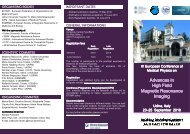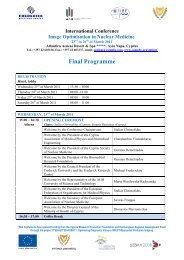medical physics international - Cyprus Association of Medical ...
medical physics international - Cyprus Association of Medical ...
medical physics international - Cyprus Association of Medical ...
- No tags were found...
You also want an ePaper? Increase the reach of your titles
YUMPU automatically turns print PDFs into web optimized ePapers that Google loves.
MEDICAL PHYSICS INTERNATIONAL Journal, vol.1, No.1, 2013ACCREDITATION OF MEDICAL PHYSICS EDUCATIONAL PROGRAMSIN NORTH AMERICAGeorge Starkschall, PhD 1 , Wayne Beckham, PhD 2 , William R Hendee, PhD 31Houston TX USA, 2 Victoria BC Canada, 3 Rochester MN USAAbstract- The purpose <strong>of</strong> this paper is to provide thereader with a description <strong>of</strong> the accreditation process for<strong>medical</strong> <strong>physics</strong> educational programs in North America bythe Commission on Accreditation <strong>of</strong> <strong>Medical</strong> PhysicsEducational Programs (CAMPEP). Forty graduateprograms and 65 residency programs are currentlyaccredited. Programs desiring accreditation must prepare aSelf-Study document, which is reviewed by an appropriateCAMPEP Review Committee. Following approval <strong>of</strong> theSelf-Study, a site visit team visits the program and preparesa recommendation to the Review Committee. Afterdiscussion and vote by the Review Committee, thedocumentation is forwarded to the Board <strong>of</strong> Directors forfinal approval. Accreditation is for up to five years and isrenewable. The introduction <strong>of</strong> the accreditation processhas resulted in an increase in the passing rate in theAmerican Board <strong>of</strong> Radiology certification examinations forcandidates completing accredited educational programs.Running title - Accreditation <strong>of</strong> North American <strong>medical</strong><strong>physics</strong> programsKeywords- accreditation, education, <strong>medical</strong> <strong>physics</strong>INTRODUCTIONAccreditation is defined as “a process whereby apr<strong>of</strong>essional association or nongovernmental agencygrants recognition to a school or health care institution fordemonstrated ability to meet predetermined criteria forestablished standards.” [1] In North America, <strong>medical</strong><strong>physics</strong> graduate programs, residency programs, andcontinuing education programs are accredited by theCommission on Accreditation <strong>of</strong> <strong>Medical</strong> PhysicsEducational Programs (CAMPEP). The stated mission <strong>of</strong>CAMPEP is “to promote consistent quality education <strong>of</strong><strong>medical</strong> physicists by evaluating and accreditingGraduate, Residency and Continuing Education programsthat meet high standards established by CAMPEP incollaboration with its sponsoring organizations.” [2]The purpose <strong>of</strong> this paper is to provide the reader witha description <strong>of</strong> accreditation <strong>of</strong> <strong>medical</strong> <strong>physics</strong>educational programs in North America. We shall beginwith a brief history <strong>of</strong> the accreditation process for<strong>medical</strong> <strong>physics</strong> educational programs, and follow thiswith a description <strong>of</strong> the process by which CAMPEPaccredits both graduate programs and residencyprograms.HISTORY OF THE ACCREDITATION PROCESSAccreditation <strong>of</strong> <strong>medical</strong> <strong>physics</strong> educational programsin North America began in the 1970s as an informalprocess <strong>of</strong> educational review administered by theAmerican <strong>Association</strong> <strong>of</strong> Physicists in Medicine(AAPM). The first programs accredited by thismechanism were the <strong>medical</strong> <strong>physics</strong> graduate programsat the University <strong>of</strong> Oklahoma and the University <strong>of</strong>Colorado. In the 1980s the accreditation process becamemore formalized as a “service” <strong>of</strong>fered by the AAPMthrough an AAPM-controlled entity named theCommission on Accreditation <strong>of</strong> Educational Programsfor <strong>Medical</strong> Physicists. The first graduate programs togain accreditation through this more formal process werethe programs in <strong>medical</strong> <strong>physics</strong> at Wayne StateUniversity (1988), The University <strong>of</strong> Wisconsin (1988),The University <strong>of</strong> Texas – Houston (1989) and McGillUniversity (1993). At this time, concern over liabilitycaused the AAPM to transfer the accreditation process toan independent body, and CAMPEP was <strong>of</strong>ficiallyformed and incorporated in Illinois in 1994. CAMPEPwas initially sponsored by three organizations in theUnited States, the AAPM, the American College <strong>of</strong>Radiology (ACR), and the American College <strong>of</strong> <strong>Medical</strong>Physics (ACMP). The Canadian College <strong>of</strong> Physicists inMedicine (CCPM) joined the list <strong>of</strong> sponsors in 2001, andwas replaced by the Canadian Organization <strong>of</strong> <strong>Medical</strong>Physics (COMP) in 2010. In 2012, after the ACMP wasincorporated into the AAPM, the Radiological Society <strong>of</strong>North America (RSNA) and the American Society forRadiation Oncology (ASTRO) joined as sponsors. Thefirst continuing education programs were accredited in1995 and the first residency program accredited was theprogram at the Washington University School <strong>of</strong>Medicine (1997).The need for <strong>medical</strong> <strong>physics</strong> educational programs tobecome accredited became more critical in 2002, whenthe American Board <strong>of</strong> Radiology (ABR) mandated thatall <strong>medical</strong> physicists desiring to take the certification22






